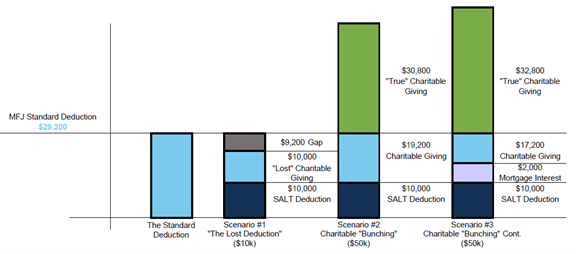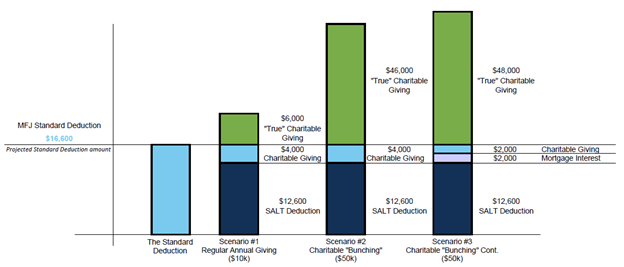
At SignatureFD, we believe giving back can be one of the most meaningful ways to find your Net Worthwhile®. As the end of 2024 approaches, charitable giving may be at the forefront of your year-end planning. This usually begs the question, “How can I make a meaningful impact on the causes I care most about while optimizing my financial plan?”
Below, we’ve identified three key elements we believe are crucial to successful philanthropic strategies: charitable bunching, Donor Advised Funds (DAFs), and Qualified Charitable Distributions (QCDs). These strategies allow many donors to navigate tax complexities, maximize charitable contributions, and help provide a brighter future for the causes they hold dear.
Before implementing a charitable giving strategy, it is important to review the increased standard deduction thresholds to gift in a tax-efficient manner. Below, we’ve outlined the 2024 standard deduction rates.
|
Filing Status: |
2024 STANDARD DEDUCTION |
|
SINGLE |
$14,600 |
|
MARRIED (JOINT) |
$29,200 |
|
MARRIED (SEPARATE) |
$14,600 |
|
HEAD OF HOUSEHOLD |
$21,900 |
|
OVER 65 OR BLIND (MARRIED) |
$1,550 |
|
OVER 65 OR BLIND (SINGLE) |
$1,950 |
Each year, taxpayers can either take the standard deduction or itemize expenses. In terms of charitable giving, charitable contributions are deducted from income through an itemized expense report, and the standard deduction acts as a “hurdle” rate. Most taxpayers do not itemize, but those that do primarily deduct state and local taxes (SALT), mortgage interest, and charitable gifts. Please refer to the following illustration and scenarios for further explanation:

Scenario #1 – If your aggregate itemized deductions fall below your corresponding standard deduction amount, you should take the standard deduction. As a result, your charitable gift will not receive a tax deduction.
Scenario #2 – To reduce the risk of “lost” deductions, consider the timing of your gifts. For example, if you typically give $10,000 per year, you could gift $50,000 this year to fund the next five years of your giving. This strategy is referred to as “charitable bunching.” As a result, you exceed the standard deduction “hurdle rate” and deduct your itemized expenses in the year you chose to “bunch your gifts.”
Scenario #3 – As you incorporate more itemized deductions (such as qualified mortgage interest), your “bunching” offers a more significant tax benefit.
Note: The Tax Cuts and Jobs Act (2017) is set to expire after 2025. At that time, the standard deduction will decrease close to half of what it is today. If reduced, more individuals may start itemizing after 2025 due to a lower “hurdle rate.” Please refer to the following illustration, with a reduced standard deduction limit, for further explanation:

As depicted in scenario #1, your regular annual giving amount may exceed the lower standard deduction when combined with other deductions (like the unlimited SALT deduction). As such, “charitable bunching” may become less effective after the Tax Cuts and Jobs Act expires.
Before you consider making larger charitable gifts ahead of the Tax Cuts and Jobs Act expiration, please note that charitable deductions are limited by your adjusted gross income (AGI). Deductions for charitable cash contributions are limited to 50% or 60% of AGI (depending on whether you give capital gain property in addition to the cash). So, if your AGI is $100,000, you could deduct up to $50,000 or $60,000. Long-term appreciated assets (such as stock held for more than a year) to most charities and donor-advised funds are eligible for a deduction of up to 30% of AGI. If you exceed these limits, you may carry forward the unused portion of your deduction for up to five years. We recommend consulting your CPA and financial advisor for the amount and timing of your charitable gifts.
Below are two other charitable giving strategies you may leverage for your year-end giving.
Donor-Advised Funds (DAFs): To implement this strategy, gift cash or appreciated assets to a charitable investment account and receive a charitable deduction for that year up to the total amount donated (subject to AGI limitations). Donating appreciated, long-term assets to a DAF can help minimize capital gains taxes while providing an income tax deduction. At the time of the gift, you do not need to specify which charities you want to support. When you are ready to distribute funds from the DAF, you submit a grant recommendation naming the charity or charities of your choice. SignatureFD partners with several DAF platforms including Schwab Charitable, Fidelity Charitable, Cobb Community Foundation, Community Foundation for Greater Atlanta, Foundation for the Carolinas, and National Christian Foundation.
Qualified Charitable Distributions (QCDs): This strategy is effective if you are age 70 ½ or older. To complete a QCD, you may send up to $105,000 from your IRA directly to a charity each year. The QCD will count towards your required minimum distribution (RMD), if applicable, but will not count toward your taxable income. With lower taxable income and thus lower adjusted gross income (AGI), you may qualify for tax credits/deductions and reduce Medicare IRMAA, amongst other benefits.
If you implement this strategy, we recommend working with your CPA and financial advisor to help you follow the IRS rules and navigate tax nuances. For instance, IRA distributions become ineligible for QCD treatment if the funds come directly to you or if they don’t end up with a qualified charity. Additionally, your IRA custodian will typically not show a QCD on your 1099-R. As a result, your CPA must manually add this to your 1040 tax form – something often missed without watchful advisors.
Of course, it is always important to start by asking why. The “why” for most charitable contributions is not simply to gain a tax deduction but to give back to the communities and people you care about.
Do you or someone you know need help planning your charitable giving activities? Talk to your SignatureFD advisor or please reach out to the SignatureGENEROSITY team at SignatureGENEROSITY@signaturefd.com to learn more about our approach to strategic generosity and start your personalized Generosity Blueprint journey.





